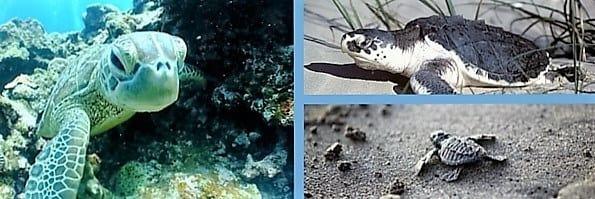Wildlife Ordinances & Regulations
Scallop Regulations, Florida Sea Turtles Rules and Leave No Trace Ordinance
Leave No Trace Ordinance
2015 was a big year for our county’s beaches. From Cape San Blas to Port St Joe, a “Leave No Trace” ordinance was issued as a way to educate both locals and visitors alike on how everyone can do their part to help preserve our beautiful stretches of coastline for future generations.
The ordinance can be boiled down to 12 simple words: Anything you bring to the beach should leave the beach with you. From now on, if you do not adhere to this very simple rule, any personal item left on the beach longer than one hour after posted sunset times will be removed and disposed of.
Other rules in the Leave No Trace ordinance include:
Digging holes. If you dig a hole or build a sandcastle, simply make sure to fill in the hole or flatten out your creation before you leave the beach.
Bonfires. Bonfires are allowed in designated areas. Make certain that your bonfire is at least 100 feet away from any structures and follow basic fire safety rules. You are only allowed to burn natural wood and you must extinguish and clean up your fire when you are done.
No trashing the beach. This is pretty much a no-brainer, but pick up and dispose of ALL of your trash in designated disposal areas and receptacles. Leave all containers and bottles made of glass at home.
There are other common sense rules that everyone should follow, whether or not they are part of this new ordinance.
Every year, our sea turtle friends come back to the beaches to lay their eggs and the resulting teeny tiny babies face an absolute perilous journey to make it into the water. We all need to make sure we never make that journey any more difficult for them then it needs to be! Please take care to follow these simple guidelines help ensure their safe passage. Please do not disturb any of our other wildlife neighbors as well.
Stay off of dune areas and out of any sea oats; it’s important to our beach’s ecological preservation to leave these natural barriers and filters intact. Fines may be leveled for violations of these rules.
Be sure to clean up and keep control over any pets, in designated pet areas.
Be sure to be careful when boating or operating any vessels near the shore. Stay away from sensitive areas. If you get grounded, get out and walk your boat back into deeper waters.
If you are planning to do any shore fishing, make certain that you have the proper license to do so. These are easily obtained from many nearby vendors and outfitters
Remember, these rules and ordinances are meant to protect our beaches, wildlife AND our beach-goers. There is plenty of signage around to remind everyone about what to do and not to do. The presence of all these signs will also help in potential emergency situations, as they have number that will act a reference point for emergency responders to the area quickly
One more important rule – ENJOY YOUR DAY AT THE BEACH.
Oh, and Leave No Trace of a nasty sunburn on your skin! WEAR SUNSCREEN and reapply often!
Scallop Regulations Of St. Joe Bay Coastal Region
Scalloping in St. Joe Bay is extremely popular with locals and visitors alike, but there are strict regulations covering the fragile, and often very limited, scallop population.
- Scalloping is permitted only in certain waters, including St. Joseph Bay.
- State waters in the Gulf of Mexico open to scallop harvest from the Pasco-Hernando County line (near Aripeka) to the west bank of the Mexico Beach Canal in Bay County.
- Scallop Season runs July 1-September 10 only. Harvesting scallops at any other time is illegal.
- It is illegal to possess bay scallops on water outside open harvest areas. It is also illegal to land scallops outside open harvest areas. For example, it would be legal to take scallops from waters off the Hernando County coast, but illegal to dock your boat in Pasco County with the scallop catch onboard.
- People wading in shallow areas at low tide do not need a license, but cannot use dive masks or snorkels to help them find scallops.
- Bay scallops may be harvested only by hand, or with a landing or dip net.
- All scallopers operating from any boat must have a valid saltwater fishing license from the state.
- Each person is limited to two gallons of whole scallops, or one pint of meat per day.
- A boatload of five or more people can take no more than 10 gallons total of whole scallops, or four pints of meat total per day.
- If taking a boat into shallow bay waters, be particularly careful not to injure or rip out the fragile sea grass with the boat motor.
It takes literally years for sea grass to rejuvenate after such an injury, and destruction of sea grass beds is extremely detrimental to the bay’s ecology.
If your boat is too large to safely navigate the shallows and sea grass beds, use poles or paddles to exit the sea grass, or use a different, more shallow-draft boat.
Florida Sea Turtles

One of the most ancient creatures on Earth, Florida sea turtles have been around for more than one hundred million years, meaning they were swimming around during the time of the dinosaurs.
Sea turtles begin coming ashore to next in May and continue the process through October. A female turtle only nests every two or three years, but is able to lay several nests throughout the season. After dragging herself up the beach she uses her back flippers to dig a hole and deposits up to 100 eggs. She covers the nest with sand then leaves, never to return, leaving the eggs on their own to determine their own fate.
The eggs incubate for two months. As the babies hatch out of their shells, their thrashing causes the walls of the nest to collapse and the sand level to lift the hatchlings to the surface. They emerge once the sand has cooled, which is why most of the babies start their journeys at night. They scramble to the water and latch onto the drifting seaweed beds offshore. Amazingly, the babies live among the beds for several years, eating and growing, before finally heading out to the Gulf.
Sadly only one out of as many as ten thousand babies will survive all the way through to adulthood. Their entire lives are spent in ocean waters. Only the females come ashore and that is only to nest. Sea turtles aren’t even capable of reproducing until they are in some cases, 50 years old. For these reasons and many more, many species of sea turtle remain endangered or at least protected on the Endangered Species list. Sea turtles are classified as a Protected Species under the Endangered Species Act. It is the responsibility of all residents and visitors alike to ensure that these delicate creatures are not exposed to any harm, even if inadvertent, while they nest and develop on our beaches.
Please follow the rules below to help keep our Florida sea turtles safe:
- Make certain to shield all interior lighting from showing up on the beaches and exinguish all exterior lighting at night so as not to disturb the turtles
- Use turtle safe flashlights on the beach at night, such as a red LED light
- Do not use flashes when taking photos of turtles or nests (including flashes on cell phone cameras)
- Do NOT disturb any areas marked as nesting areas on the beach
- Remove ALL beach equipment every evening
- Take every single thing you bring to the beach away with you. Leave no trash or any trace of your visit behind
- Do not, under ANY circumstance, touch turtles, nests, or hatchlings
- Don’t dig trenches for hatchlings or otherwise disturb the natural terrain of the beaches. If you must dig, fill in any holes you create during your visit before you leave. Leave the beach as you found it.
- Leave NO plastic on the beach. No plastic bags, containers, caps, rings; do not use any products with micro-beads
Plastics are particularly dangerous to the recently hatched baby turtles as they make their arduous journey from their nest, across the sand to the ocean. After the babies exhaust their internal food supply from their yolk-sack, they instinctively will try to find food in the sand. The babies cannot distinguish their natural foods from tiny bits of plastic. Consuming plastic is one of the leading causes of death for both adult and baby sea turtles.
Another extremely harmful human activity that can hurt the babies is artificial light. The babies heading down to the water instinctively move towards the brightest nearby place, which, for many millions of years, would be the moon light reflecting off of the ocean. Artificial light could cause them to go the wrong way, ending in what is likely to be their doom. If you are staying in a property close to the water, please draw all the shades at night and turn off all exterior lighting.
The Florida Coastal Conservancy is a great source of education on the areas sea turtles. The Conservancy sends out patrols of volunteers to monitor and track sea turtle activity along the Saint Joseph Peninsula.
Remember, you are not the only visitors to our wonderful beaches. With a little bit of respect and attention, you can help keep our turtles safe and ensure the preservation of this ancient species for future generations to enjoy.


